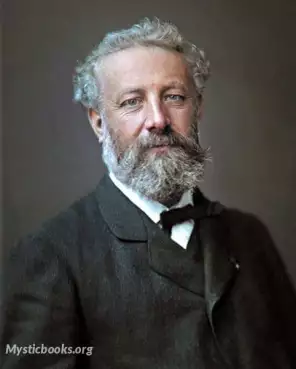
The Mysterious Island
by Jules Verne
'The Mysterious Island' Summary
During the American Civil War, five Northern prisoners of war escape during the Siege of Richmond, Virginia, by hijacking a hydrogen-filled observation balloon. The escapees are Cyrus Smith, a railroad engineer in the Union army (named Cyrus Harding in Kingston's version); his ex-slave and loyal follower Neb (short for Nebuchadnezzar); Bonadventure Pencroff, a sailor (who is addressed only by his surname; in Kingston's translation, he is named Pencroft); his protégé and adopted son Harbert Brown (called Herbert in some translations); and the journalist Gedéon Spilett (Gideon Spilett in English versions). The company is completed by Cyrus' dog "Top".
After flying in a great storm for several days, the group crash-lands on a cliff-bound, volcanic, unknown island, described as being located at 34°57′S 150°30′W (Southern Pacific Ocean/Asian:Oceanian side), about 2,500 kilometres (1,600 mi) east of New Zealand. They name it "Lincoln Island" in honor of Abraham Lincoln. With the knowledge of the brilliant engineer Smith, the five are able to sustain themselves on the island, producing fire, pottery, bricks, nitroglycerin, iron, a simple electric telegraph, a cave home inside a stony cliff called "Granite House", and even a seaworthy ship, which they name the "Bonadventure".
During their stay on the island, the group endures bad weather and domesticates an orangutan, Jupiter, abbreviated to Jup (or Joop, in Jordan Stump's translation). There is a mystery on the island in the form of an unseen deus ex machina, responsible for Cyrus' survival after falling from the balloon, the mysterious rescue of Top from a dugong, the appearance of a box of equipment (guns and ammunition, tools, etc.), and other seemingly inexplicable occurrences.
The group finds a message in a bottle directing them to rescue a castaway on nearby Tabor Island, who is none other than Tom Ayrton (from In Search of the Castaways). On the return voyage to Lincoln Island, they lose their way in a tempest but are guided back to their course by a mysterious fire beacon.
Ayrton's former companions arrive by chance on Lincoln Island and try to make it into their lair. After some fighting with the protagonists, the pirate ship is mysteriously destroyed by an explosion. Six of the pirates survive and kidnap Ayrton. When the colonists go to look for him, the pirates shoot Harbert, seriously injuring him. Harbert survives, narrowly cheating death. The colonists at first assume Ayrton has been killed, but later they find evidence that he was not instantly killed, leaving his fate uncertain. When the colonists rashly attempt to return to Granite House before Harbert fully recovers, Harbert contracts malaria but is saved by a box of quinine sulfate, which mysteriously appears on the table in Granite House. After Harbert recovers, they attempt to rescue Ayrton and destroy the pirates. They discover Ayrton at the sheepfold, and the pirates dead, without any visible wounds.
The secret of the island is revealed to be Captain Nemo's hideout, and home port of the Nautilus. Having escaped the Maelstrom at the end of Twenty Thousand Leagues Under the Sea, the Nautilus sailed the oceans of the world until all its crew except Nemo had died. Now an old man, Nemo returned the Nautilus to its secret port within Lincoln Island. Nemo had been the mysterious benefactor of the settlers, providing them with the box of equipment, sending the message revealing Ayrton, planting the torpedo that destroyed the pirate ship, and killing the pirates with an "electric gun". On his death bed, Captain Nemo reveals his true identity as the lost Indian Prince Dakkar, son of a raja of the then-independent territory of Bundelkund and a nephew of the Indian hero Tippu-Sahib. After taking part in the failed Indian Rebellion of 1857, Prince Dakkar escaped to a desert island with twenty of his compatriots and commenced the building of the Nautilus and adopted the new name of "Captain Nemo". Before he dies, Nemo gives them a box of diamonds and pearls as a keepsake. Nemo's final words are "God and my country!" ("Independence!", in Verne's original manuscript). The Nautilus is scuttled and serves as Captain Nemo's tomb.
Afterward, the island's central volcano erupts, destroying the island. Jup the orangutan falls into a crack in the ground and dies. The colonists, forewarned of the eruption by Nemo, find shelter on the last remaining piece of the island above sea level. They are rescued by the ship Duncan, which had come to rescue Ayrton, but was redirected by a message Nemo had previously left on Tabor Island. After they return to the United States they form a new colony in Iowa, financed with Nemo's gifts.
Book Details
Language
EnglishOriginal Language
FrenchPublished In
1875Genre/Category
Tags/Keywords
Authors

Jules Verne
France
Verne is considered to be an important author in France and most of Europe, where he has had a wide influence on the literary avant-garde and on surrealism. His reputation was markedly different in an...
Books by Jules VerneDownload eBooks
Listen/Download Audiobook
Related books

Governess; Or, The Little Female Academy by Sarah Fielding
The Governess, or The Little Female Academy, written by Sarah Fielding in 1749, holds the distinction of being the first full-length novel specificall...

Essays in Idleness by Agnes Repplier
Agnes Repplier was a popular and highly regarded essayist of the late 19th and early 20th century, who was also well known on the lecture circuit. Her...

The Phantom Regiment; or, Stories of "Ours" by James Grant
The novel follows the adventures of a group of Scottish soldiers who serve in a regiment of the British army during the Peninsular War in Spain. The s...

Harper's Young People, Vol. 01, Issue 06, Dec. 9, 1879 by Various
Harper's Young People, published in 1879, was a weekly magazine designed for children. It featured a diverse range of content including serialized sto...

Wonderwings and other Fairy Stories by Edith Howes
A collection of three short stories about fairies, complete with good moral lessons (as every fairy tale should be). (Summary by Claire Goget)

Ὁμήρου Ὀδύσσεια (Ραψῳδία 14) - The Odyssey (Book 14) by Homer
This book presents the fourteenth book of Homer's *Odyssey*, focusing on Odysseus's encounter with Eumaeus, the swineherd, while disguised as a beggar...

Tales of Troy: Ulysses the Sacker of Cities by Andrew Lang
This book tells the story of Ulysses, a central figure in Greek mythology, known for his cunning and resourcefulness. It explores his adventures durin...

Mother West Wind 'Why' Stories by Thornton Burgess
Thornton W. Burgess was a conservationist and prolific author of children's books. His gently humorous stories about the animals of the meadows and wo...

Harper's Young People, Vol. 01, Issue 03, Nov. 18, 1879 by Various
Harper's Young People was a weekly publication aimed at children, featuring a variety of content including serialized stories, short stories, fiction...

Death Ship by William Clark Russell
Death Ship, by William Clark Russell, is a classic maritime ghost story that follows the harrowing experience of Geoffrey Fenton, who encounters the l...
Reviews for The Mysterious Island
No reviews posted or approved, yet...